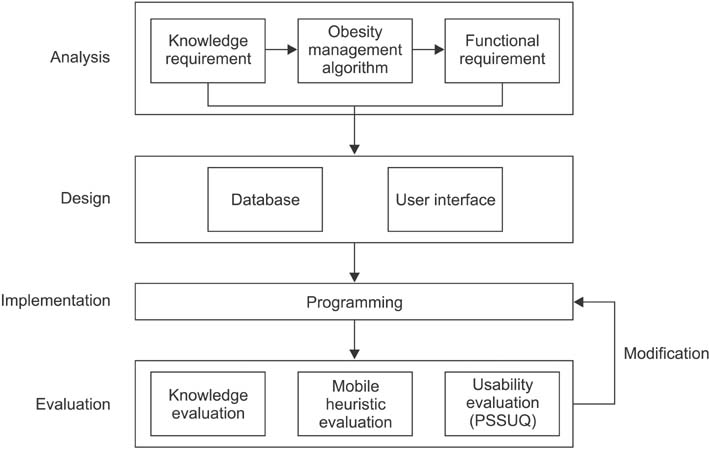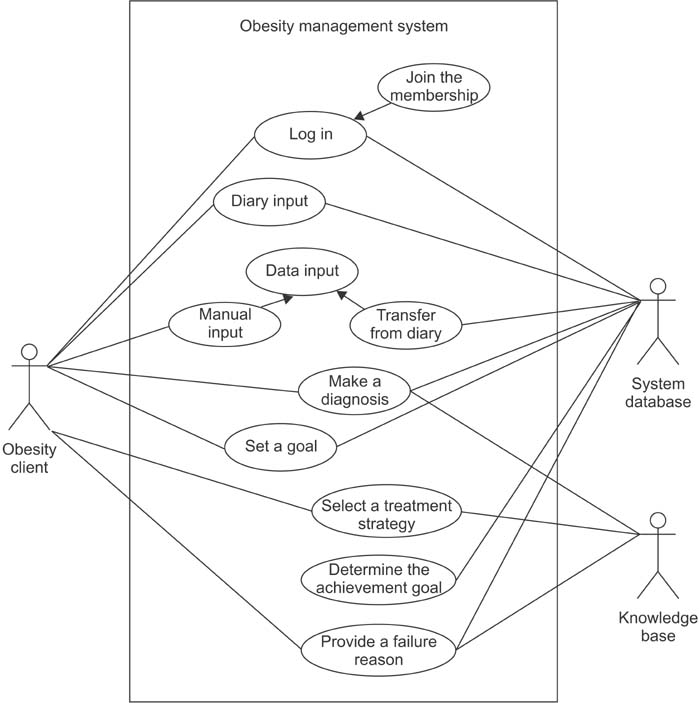Development of a Smartphone Application for Clinical-Guideline-Based Obesity Management
- Affiliations
-
- 1College of Nursing, Seoul National University, Seoul, Korea. hapark@snu.ac.kr
- 2Systems Biomedical Informatics Research Center, Seoul National University, Seoul, Korea.
- 3Research Institute of Nursing Science, Seoul National University, Seoul, Korea.
- KMID: 2284593
- DOI: http://doi.org/10.4258/hir.2015.21.1.10
Abstract
OBJECTIVES
The purpose of the study was to develop and evaluate a clinical-guideline-based smartphone application ('app') for obesity management.
METHODS
Obesity-related knowledge and functional requirements were extracted from clinical practice guidelines, a literature review, and consultations with experts. The extracted knowledge was used to design obesity-management algorithms, and the functions of the developed app are presented through a use case diagram and activity diagrams. The database and user interface were designed and then an app was developed. The proficiency and efficiency of the algorithm were evaluated using scenarios, while the user interface was assessed using a mobile heuristics evaluation tool, with its usability determined using the Post-Study System Usability Questionnaire.
RESULTS
In total, 131 obesity-related knowledge statements and 11 functions for the app were extracted, and 5 algorithms (comprising 1 main algorithm and 4 subalgorithms) were developed. The database comprised 11 tables and 41 screens. The app was developed using the Android SDK platform 4.0.3, JDK 1.7.0, and Eclipse. The overall proficiency and efficiency scores of the algorithm were 88.0 and 69.1, respectively. In heuristics tests, 57 comments were made, and the mean usability score was 3.47 out of 5. Thirteen usability problems were identified by the heuristics and usability evaluations.
CONCLUSIONS
The app developed in this study might be helpful for weight management because it can provide high-quality health information and intervention without spatial or temporal constraints. However, the clinical effectiveness of this app still requires further investigation.
MeSH Terms
Figure
Cited by 5 articles
-
Social Media in Clinical Practice
Mona Choi
Healthc Inform Res. 2015;21(2):138-140. doi: 10.4258/hir.2015.21.2.138.Are Currently Available Wearable Devices for Activity Tracking and Heart Rate Monitoring Accurate, Precise, and Medically Beneficial?
Fatema El-Amrawy, Mohamed Ismail Nounou
Healthc Inform Res. 2015;21(4):315-320. doi: 10.4258/hir.2015.21.4.315.Factors Affecting Acceptance of Smartphone Application for Management of Obesity
Eunjoo Jeon, Hyeoun-Ae Park
Healthc Inform Res. 2015;21(2):74-82. doi: 10.4258/hir.2015.21.2.74.Development of Child-Teen Obesity Treatment Service Platform
Kahyun Lim, Byung Mun Lee, Youngho Lee
Healthc Inform Res. 2016;22(3):243-249. doi: 10.4258/hir.2016.22.3.243.Development and Cross-cultural Validation of the Korean Version of SMArtphone’s uSability Heuristics (SMASH)
Yeo Won Jeong, Jung A Kim
Healthc Inform Res. 2017;23(4):328-332. doi: 10.4258/hir.2017.23.4.328.
Reference
-
1. Obesity: preventing and managing the global epidemic. Report of a WHO consultation. World Health Organ Tech Rep Ser. 2000; 894:i–xii. 1–253.2. Korea Ministry of Health and Welfare. Korea National Health and Nutrition Examination Survey. Seoul, Korea: Ministry of Health and Welfare;2011.3. Goessens BM, Visseren FL, de Nooijer J, van den Borne HW, Algra A, Wierdsma J, et al. A pilot-study to identify the feasibility of an Internet-based coaching programme for changing the vascular risk profile of high-risk patients. Patient Educ Couns. 2008; 73(1):67–72.
Article4. Jeon HO, Kim O. The effects of an internet based coaching program for obesity management in hypertensive patients. Korean J Adult Nurs. 2011; 23(2):146–159.5. Patrick K, Griswold WG, Raab F, Intille SS. Health and the mobile phone. Am J Prev Med. 2008; 35(2):177–181.
Article6. Breton ER, Fuemmeler BF, Abroms LC. Weight loss-there is an app for that! But does it adhere to evidence-informed practices? Transl Behav Med. 2011; 1(4):523–529.
Article7. Jeon E, Park HA, Min YH, Kim HY. Analysis of the information quality of Korean obesity-management smartphone applications. Healthc Inform Res. 2014; 20(1):23–29.
Article8. Bower H. Internet sees growth of unverified health claims. BMJ. 1996; 313(7054):381.
Article9. Tu SW, Musen MA. Representation formalisms and computational methods for modeling guideline-based patient care. Stud Health Technol Inform. 2001; 83:115–132.10. Peleg M. Clinical decision support: the road ahead. In : Greenes RA, editor. Guidelines and workflow models. San Diego (SD): Elsevier;2007. p. 281–306.11. National Heart, Lung, and Blood Institute. Clinical guidelines on the identification, evaluation, and treatment of overweight and obesity in adults. Bethesda (MD): National Heart, Lung, and Blood Institute;1998.12. Lewis JR. Psychometric evaluation of the PSSUQ using data from five years of usability studies. Int J Hum Comput Interact. 2002; 14(3-4):463–488.
Article13. Choi J, Bakken S. Creation of a gold standard for validation of a computer-interpretable depression screening guideline. Stud Health Technol Inform. 2006; 122:95–99.14. Bertini E, Gabrielli S, Kimani S. Appropriating and assessing heuristics for mobile computing. In : Proceedings of the Working Conference on Advanced Visual Interfaces; 2006 May 23-26; Venezia, Italy. p. 119–126.15. Kushner R. Roadmaps for clinical practice: case studies in disease prevention and health promotion: assessment and management of adult obesity: a primer for physicians. Chicago (IL): American Medical Association;2003.16. National Institute for Health and Clinical Excellence. Obesity: guidance on the prevention, identification, assessment and management of overweight and obesity in adults and children (NICE Clinical Guideline, No. 43). London: National Institute for Health and Clinical Excellence;2006.17. Korean Society for the Study of Obesity. Obesity, barometer of disease. Seoul, Korea: Korean Society for the Study of Obesity;2010.18. Korean Endocrine Society. Korean Society for the Study of Obesity. Management of Obesity, 2010 Recommendation. Endocrinol Metab. 2010; 25(4):301–304.19. Eysenbach G. Medicine 2.0: social networking, collaboration, participation, apomediation, and openness. J Med Internet Res. 2008; 10(3):e22.
Article20. Shahar Y, Young O, Shalom E, Galperin M, Mayaffit A, Moskovitch R, et al. A framework for a distributed, hybrid, multiple-ontology clinical-guideline library, and automated guideline-support tools. J Biomed Inform. 2004; 37(5):325–344.
Article21. Kim HY, Park HA, Cho I, Kim J, Lee J. Encoding and verification of a computer interpretable guideline: a case study of pressure-ulcer management. HIM J. 2013; 12. 4. [Epub]. http://dx.doi.org/10.12826/18333575.2013.0016.Kim.22. Pierotti D. Heuristic evaluation: a system checklist. Norwalk (CT): Xerox Corporation;1995.23. Kim H, Kim T, Joo M, Yi S, Yoo C, Lee K, et al. Design of a calorie tracker utilizing heart rate variability obtained by a nanofiber technique-based wellness wear system. Appl Math Inf Sci. 2011; 5(2):171S–177S.24. Butler KA. Usability engineering turns 10. Interactions. 1996; 3(1):58–75.
Article25. Nielsen J. Usability engineering. San Diego (CA): Morgan Kaufmann;1994.
- Full Text Links
- Actions
-
Cited
- CITED
-
- Close
- Share
- Similar articles
-
- Development of a Smartphone Application for Clinical-Guideline-Based Obesity Management
- Development of a Smartphone Application Prototype for Child Obesity Prevention: Rationale and Study Design of Acceptability and Feasibility Tests
- The Development and Application Effects of a Fatigue Self-Care Smartphone Application for Lung Cancer Patients Receiving Chemotherapy
- Analysis of the Information Quality of Korean Obesity-Management Smartphone Applications
- Development of Smartphone Application for Cognitive Behavioral Therapy-Based Case Management in Patients with Schizophrenia







